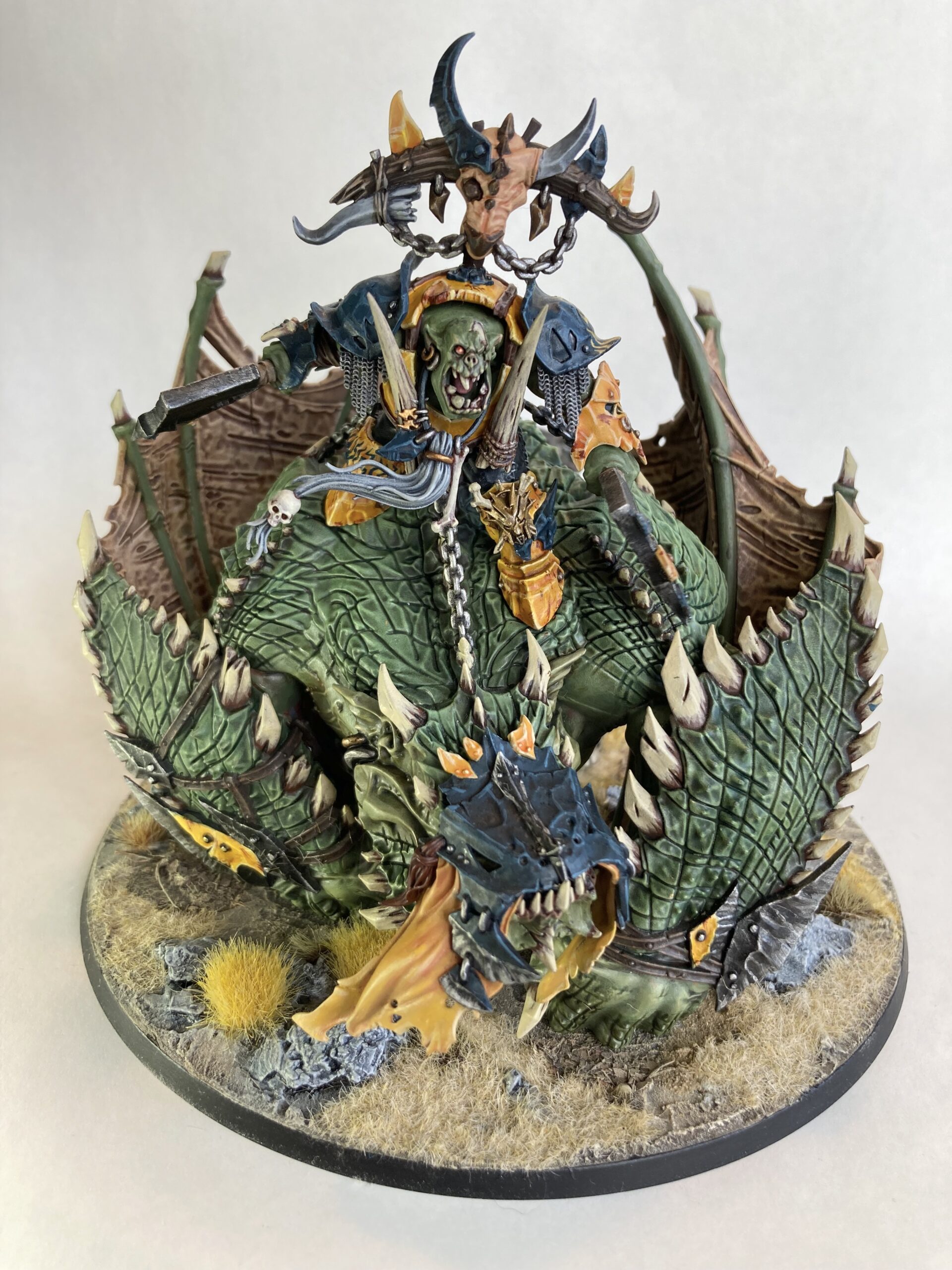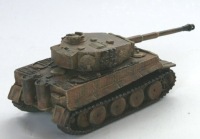Putting some life into your bases
You may have seen this article set I wrote back in 2008 for “the One Ring ” web site and the TAG web site. I have copied it there in full length.
By Martin Ellis
Hello everybody.
I have been having plenty of fun lately sculpting.
My new skills have involved sculpting bases for my Goblin warriors that I have finally painted.
In this article I would like to show you a step-by-step process to sculpt some small creatures on your bases. And it is really easy. Materials and tools are easily available and a basic skill level is needed.
Introduction to project.
What I am trying to achieve is to have some small creatures on a few of the bases just to spice up the models. I have in excess of 150 Goblins warriors and although we are blessed with 12 different poses of Goblins, when they are painted the same they all look THE SAME. So instead of converting all my goblins to look individual I decided to make the base individual… it is easier and looks great!
Materials:
DAS PRONTO air-drying modelling clay.
A word on DAS. Das is cheap and it dries in the air. This means you do have some time limit to work with it but this is over an hour. I find this great for bases because you can put it down for a while and not worry about it setting hard on you. Water soluble, DAS gets very smooth and degrades with too much water this is like Milliput. Not only does this allow you to repair and smooth things out easier than Green Stuff (GS) but makes pushing volumes around from one side of your base to the other easier too. This is great stuff to use if practising to sculpt Milliput. Ploymer Clay acts more like GS.
Sculpting tools.
Sculpting tool:
I use a tool with a round tipped curved paddle on one end and small sharp leaf shape on the other. It is good for small detail and smoothing and pushing large areas, without having to swap tools.
Plastic sprue:
The geometric designs in Dwarf Mines are based on squares and triangles. When I press designs into DAS I use pieces of the plastic sprue from the goblins. I carve the end into a triangle or square and use it to repeat the exact shape into the clay.
The bases:
I have made seven bases for you and photographed the procedure.
I will show each on it’sown page.
1. Small Spider
2. Sole Spider
3. Centipede and spider
4. Spider pair
5. Mouse
6. Rat eating
7. Snake
1 Small Spider
I will start with the small spider. It is the easiest to sculpt.
· Start with a small ball of clay. Push it onto the base clay, which is
also still wet and soft.
Now cut the ball into 1/3 but not all the way down.
· Round the large section into a body and flatten and slightly round
the front.
· Under cut the body pieces and bank up the excess clay into the
middle side of each half of the body.
· From the excess clay you cut four stumps of legs and gently shape
down to the ground. These will form only the close in sections of legs.
· The outside lengths of the legs are then not sculpted but a
likeness is carved into the smooth base surface. This will look like
fine legs when the base is black washed later.
· Moving onto the face, make a little vertical cut at the front of the face
to make the front fangs of the Spider. And add any eyes if you can at
all at this size.
· And there we are finished sculpting a small spider.


2 Sole Spider
This is a much larger spider and has full length legs sculpted.
· The method to sculpt this spider is the same as for the small spider.
However there is much more clay to shift from under the ball shapes of
the two body parts. This clay is pushed and smoothed onto the base as
a good fixing too. So to re-cap:
i Attach ball of clay.

ii Cut into 1/3’s only not all the way across this time.

iii Cut under the rear of the body to get clay for back legs.

iv Push clay out to ramp up clay for legs, smooth out. You may
need some water on the tool tip to help dissolve and soften
the clay.

v Smooth out the legs and cut and shape four small sausages
to the desired length and direction.


vi Cut the front of the face to get some little fangs. Add any
more detail you want and gently smooth and finish the
shape, as you like. A spider finished.

3 Centipede and spider.
A spider by itself gets lonely, so here is a centipede for it to chase.
· Take a small sausage of clay and squash onto the base. Then very
finley whisker cut many small grooves as legs across where the
sausage attaches to the base clay.
· Then nick little graduations down the spine of the centipede.
· Nick at the rear of the centipede two long tail pincers and nick and
separate widely two cuts at the head for antennae.
· Paint copper brown or even brighter. These will look good coming out
of the ground around a ring wraith base.
· Then add the spider in the same way as described above.










4 Spider pair
this sculpt is two medium spiders together on one base.
One of them looks a little more like a beetle because I split the rear
body and it could have wings.
· Start as per the sole spider above and complete.
· Make the second spider as per the first. But if you want you can
experiment and add some decoration to look different. Or you can
make a beetle by splitting the back and probably leaving two legs off
and the fangs can become longer and be antenna. This one is still a
spider.





5 Mouse
Oh how cute a little mouse. Lets see how I made it…
• This is more tricky. Start with a ball of putty shaped roughly the size of
your intended mouse. It has no tail at this stage. We look to make the
legs first. Place a couple of dimples to locate the shoulder blades.

• Cut down and under to separate the front legs from rear. Make a small
cut behind the back of the head to locate the neck.

• Draw the nose out and down and smooth with a wet tool blade. Then
dig the tip in to where each ear is and pull up and out to a point to
make two same sized ears.


• Roll a very thin sausage of clay and wet and attach the end to the
body. Then smooth and shape the body and face features as much as
possible. It is still very small.

6 Rat eating
This is a big mouse and is standing on its haunches. This isn’t as
detailed as the mouse. But when painted is looks fine. The mind fills in
any gaps of the form if painted well.
• Start with a blob of clay roughly the shape and size you need.

• Cut on each side a crevice between the rats chin and it’s fore paws.
Then cut between its rear legs and up into the tummy. Flatten some of
the base to look like the rats knees and paws.

• Roll a thin but long sausage of clay and wet and attach to the bottom
rear of the body. Form it into a nice rounded shape back toward the
front.


• Finish the face by picking the ears out as we did for the mouse. Finish
any further detail needed with a deft hand… but remember this is only
to compliment the figure on the base so doesn’t need ultra detail.
7 Snake
here is a dangerous creature.. but deadly simple to sculpt.
• Take your base.

• Roll a thin sausage.. the shape of a snake.

• Place the thin end on the base and snake it along the ground in the
desired.. pose.

• Push a dimple at the head position.

• Now flip the waste side of the sausage back over on it self.

• Push another dimple or cut at the rear of the snakes thicker head.

• Use tweezers to pull away the excess sausage of clay. Smooth the
excess to look like a snakes head.

• Using a small triangle shape cut on the end of plastic sprue press a
repeating pattern down the spine of the snake. Finish any shape detail
to the head. And then your done. The press pattern will show up well
with washing and drybrushing.. especially with different colours.


There we are finished.
Finally the bases are painted with a dilute mix of yellow Ochre and brown craft paint. This is dried and then washed with a very dilute mix of black paint and water to the consistency of ink. Then the bugs are painted their colours and dry brushed a lighter colour to bring any patterns or shades up.
The spiders have a faint purple pattern onthe back and a yellow ochre dry brush.
Here they are finished.

base coat

painted

close up shots:
Small spider. Note how washing into grooves creates leg extensions.

Sole spider. there is still some moisture under the paint… watch for this the leg roots have exposed the clay when dry brushed. Make sure there realyy dry before dry brushing!

Spider and centrepede

Spider pair

Mouse

Rat eating

Snake

And my best one climbing a wall to pounce on a centerpede.

That’s the lot for now.
I’m starting to paint Wood Elves next week… so some polymer clay pressmold flowers, plants, birds and insects will be next. Also next time your ina book or cake shop look for wedding cake decorations that have little plastic doves on wedding bands… perfect for those saintly characters.




























































